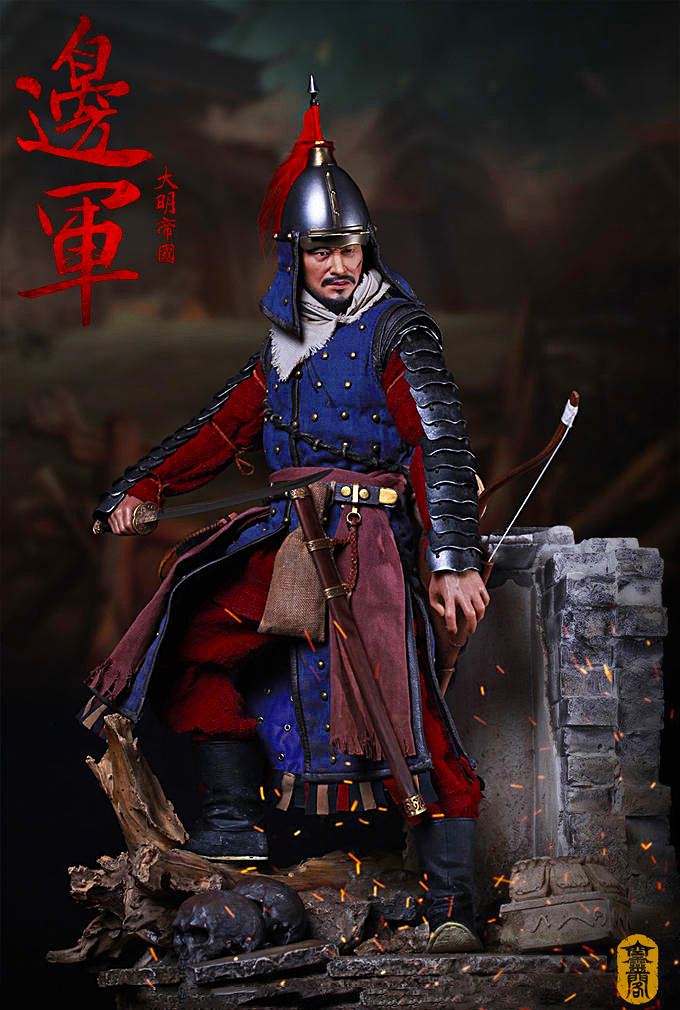
Chinese Ming Dynasty Warrior Training Chinese armor, Dynasty warriors, Armor
Qin dynasty limestone helmet and armour, used as grave goods. Han scale armour. Nanyue iron lamellar armour (original and replica) Northern Wei shield warrior wearing cord and plaque. Sui dynasty warrior with shield. Tang dynasty soldier in lamellar armour. Tang warrior wearing cord and plaque armour. Tang stone relief depicting mountain.

Antique Chinese late Ming period helmet Chinese armor, Armor, Ancient china
Helmets or tall peaked caps; it extends down over the ears and neck. It is semi-transparent. Jin- Ming Lianhua Guan (莲花冠) Lotus Crown. First worn by highest rank Taoist Maste, later also worn by the nobility.. Name originate from Ming dynasty's founder Hongwu Emperor uniting China in six direction, earth to sky, east to west, north to.

Parade helmet of Emperor Wanli (萬曆皇帝), Ming Dynasty. ANTIQUE ARMS&ARMOUR Pinterest Emperor
Zhou dynasty (c. 1046 BC-256 BC) Armour in the Zhou dynasty consisted of either a sleeveless coat of rhinoceros or buffalo hide, or leather scale armour. Helmets were largely similar to Shang predecessors but less ornate. Chariot horses were sometimes protected by tiger skins. [3] helmet fittings (leather helmet no longer extant)

Antique Chinese Ming dynasty kettle helmet Chinese armor, Ancient china, Chinese
Because of its overall form and the style of its ornament, it appears to be an early example of helmet types that are usually associated either with the later part of the Ming dynasty (1368-1644) or the more familiar ceremonial helmets of the Qing dynasty (1644-1911).

Chinese Ming dynasty helmet Chinese armor, Armor, Pendant light
The military of the Ming dynasty was the military apparatus of China from 1368 to 1644. It was founded in 1368 during the Red Turban Rebellion by Zhu Yuanzhang (Hongwu Emperor). The military was initially organised along largely hereditary lines and soldiers were meant to serve in self-sufficient agricultural communities.

Chinese Ming dynasty Phoenix wing helmet Ancient armor, Ancient warfare, Chinese armor
Ming Dynasty Helmet (1 - 1 of 1 results) Price ($) Any price Under $50 $50 to $250 $250 to $500. Plate arms of Ming dynasty, Bi Fu arms protection,armour of the Ming army, Protection armor Ming,Blackened arms protection,Steel Mastery (234) $ 959.45. Add to Favorites.

Ming Frontier Troop 明邊軍. Ming border trooper in brigandine armor and arm guards. He wore a
From 14th Century China, The Ming Dynasty is well known for it's finely crafted art (of all kinds). The Dynasty was also well known for equipping it's soldiers with the best (and most innovative) weapons available. Such was The Basic Ming Helmet. Designed for Royal Troops (possibly infantry), The Ming Helmet consisted of 2 components.

Chinese late Ming/early Qing dynasty helmet Chinese armor, Metal working, Chinese
Is there a SINGLE surviving find of Song/Ming Dynasty armor with Mountain Pattern links? Or better yet, an officer's helmet with the winged cheek plates? If not, could you just dump your favorite armor reconstruction/finds? Qing may not apply.

Chinesearmor Arm Armor, Body Armor, Geisha, Renaissance, Chinese Armor, Dynasty Warriors
Learn with Us Research Shop Search The Collection Arms and Armor Helmet Mongolian or Chinese 1350-1450 Not on view Based on its decoration and construction, this helmet appears to date from the late Yuan (1279-1368) to the early Ming dynasty (1368-1644), a period from which surviving armor is very rare.

UNIT. Ming Frontier Troops 明邊軍
1 Ancient helmets from the pre-Qin period 2 Dou Mou in the Warring States, Qin and Han Periods 3 Zhou after Wei and Jin 4 Definition and types of Kui The Chinese ancient armor protecting the head was called Zhou (胄, helmet) in the pre-Qin period. In oracle bone inscriptions, the helmet is painted as a shield with a vertical tube at the top.

Ming dynasty style lamellar armor r/ArmsandArmor
You can tell by the green rust over a near orangish tint that the first helmet is cast of bronze, while the severe rust and coloration of the plates of the second helmet indicates cast-iron. Here's a Ming Dynasty helmet below now found in a museum in Japan, as it was used in the Imjin War of the 1590s, where Joseon (Korea) and Ming (China) were.

Ming Imperial Guard Phoenix Wing Parade Helmet Chinesearmor Chinese armor, Chinese
Tibetan visor contemporary to the Ming Dynasty, Metropolitan Museum of Art. Helmet visors had been referenced sporadically in Chinese records but never in extensive detail. Many of the unearthed helmet visors which looked like a face were from the Song- Jin wars and were part of heavy cavalry helmets. Art by : 蒸魚葱

Yi Sun Sin, Tibet, Chinese Armor, Knight Armor, Armor Concept, Chinese Clothing, Ancient China
For the most part, Chinese soldiers seldom wore specialised arming garments under their armours or helmets, as such equipment are perfectly functional even without underlying padding. Still, most forms of Chinese military clothing seem to be fairly thick or possibly lightly padded, which help to prevent chafing.

Chinese Ming dynasty helmet Chinese armor, Ceiling lights, Pendant light
11 wolflance1 • 5 yr. ago So you are the armorer that make the armor? I have several questions for you: why is that your sleeves puff up at the armpits area? why are you using a trident on the helmet? Isn't trident-helmet more of a Korean thing? I've yet to see a Ming helmet with trident, either in art or on actual artefact.

Chinese Ming dynasty helmet Miğfer, Ordu
A notable improvement of Qing armour over its Ming predecessors is the addition of a type of flared cuff known as Ma Ti Xiu (馬蹄袖, lit. 'Horse hoof cuff') to armoured sleeves and vambraces to better protect the hands. Overall, Qing armour offers superior mobility, modularity, and ease of manufacture (as every components of Qing armour.

Carl Zha on Twitter "Ming Dynasty helmet with Song Dynasty style armor PS, it’s not me…
The Ming dynasty, which succeeded the Yuan (Mongol) dynasty (1206-1368), was founded by Zhu Yuanzhang. Zhu, who was of humble origins, later assumed the reign title of Hongwu. The Ming became one of the most stable but also one of the most autocratic of all Chinese dynasties. More From Britannica. China: The Ming dynasty.